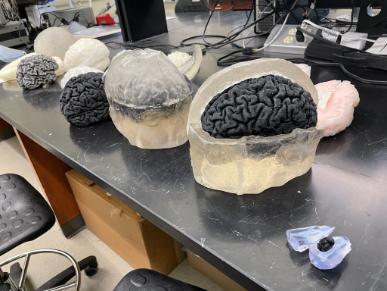Phantoms on the Brain: VCU startup creates devices for treating neuro disorders
A new start-up business that arose from research at VCU has developed one-of-a-kind brain replicas that could be used to perfect treatments for depression, Parkinson’s disease, and other disorders.
VCU Innovation Gateway helped Dr. Ravi Hadimani and researchers of his Biomagnetics Laboratory secure a patent for their anatomically accurate human “brain phantoms.”
The phantoms can play a valuable role in gauging the effectiveness of magnetic and electric fields generated by the coils that is placed on the top of the head to treat many disorders originating in the brain, Dr. Hadimani says.
“We can target specific areas of the brain and regulate neurons,” Dr. Hadimani says. “When we do that, we can reduce the symptoms of many debilitating neurological and psychiatric disorders.”
And with the phantoms, it can all be done without first putting a patient through the procedure. The phantoms could help researchers better plan for how to treat patients using currents created by transcranial magnetic stimulation (TMS), deep brain stimulation, and other methods.
The phantoms are made using MRI images of a patient’s brain. A 3D shell of the organ is created and then filled with silicon and carbon nanotubes that mimic the conductivity of regular brain tissue.
 |
Hadimani says that conductivity makes them particularly useful to clinicians who can run tests using the phantoms to ensure that electric pulses used to treat neurological disorders are reaching the right areas of a patient’s brain and, at just the right intensity, to treat them safely and effectively. The phantoms can also ensure electric currents aren’t unintentionally impacting other sensitive parts of the brain, such as the areas regulating the lungs and heart, Hadimani says.
The phantoms could play a role in treating a host of disorders. TMS has been FDA-approved to treat depression, obsessive-compulsive disorder, and smoking cessation, Hadimani says. VCU researchers also plan to use the phantoms to test new magnetic coils they’re developing to treat Parkinson’s disease and dystonia, a disorder that causes involuntary muscle contractions.
Hadimani is founding the start-up with Wesley Lohr, one of his former students in the Biomagnetics lab. Their venture is called Realistic Anatomical Model (RAM) Phantoms LLC.
“Since we use MRI images, our phantoms can be catered patient-to-patient,” Lohr says. “They can be a completely unique phantom for each patient.”
That offers the VCU start-up a key advantage over other brain phantoms that are already available from other sources, says Brittaney Ritchie, a medical devices licensing manager with VCU Innovation Gateway.
“These phantoms can be tailored to specific brains unlike the generic phantoms on the market,” Ritchie says.
Innovation Gateway has been helping Dr. Hadimani and Lohr license the phantoms to companies. Several universities have already expressed interest, Ritchie says.
Some businesses are considering using the start-up’s phantoms to test their own magnetic field-producing equipment, Hadimani says. He is seeking federal and state grants to fund additional research into the project. Hadimani and Lohr have already received a pair of grants to launch their start-up: a $75,000 grant from the Commonwealth Commercialization Fund and a $20,000 Dream2Reality grant from the Commonwealth Cyber Initiative.
While the start-up has the patent for the human version of the phantoms, another patent is pending for a rat version of their anatomically accurate brain replicas.
Those rodent brain phantoms could be used for testing neurological treatments that would normally require an actual rat.
Hadimani said one of his Ph.D students, Hamzah Magsood, created their first human brain phantom in 2018 in order to test coils being developed to treat various neurological diseases. There were no anatomically accurate phantoms to test the coils with back then, so they built their own.
Lohr came to the project later with a background in additive manufacturing and a desire to use that expertise to create biomedical devices. Lohr says that in addition to research, the phantoms would mainly be used for training new medical professionals.
“A new TMS technician or physician, instead of using the device for the first time on a patient, can instead use it on our phantoms,” Lohr says.
Dr. Hadimani, meanwhile, sees a growing need for these types of medical testing devices amid an age wave impacting the population.
“As the human population ages, these neurodegenerative disorders are becoming more prevalent,” Hadimani says. “We’ll see more of a need in the future for biomedical devices to help treat these conditions
